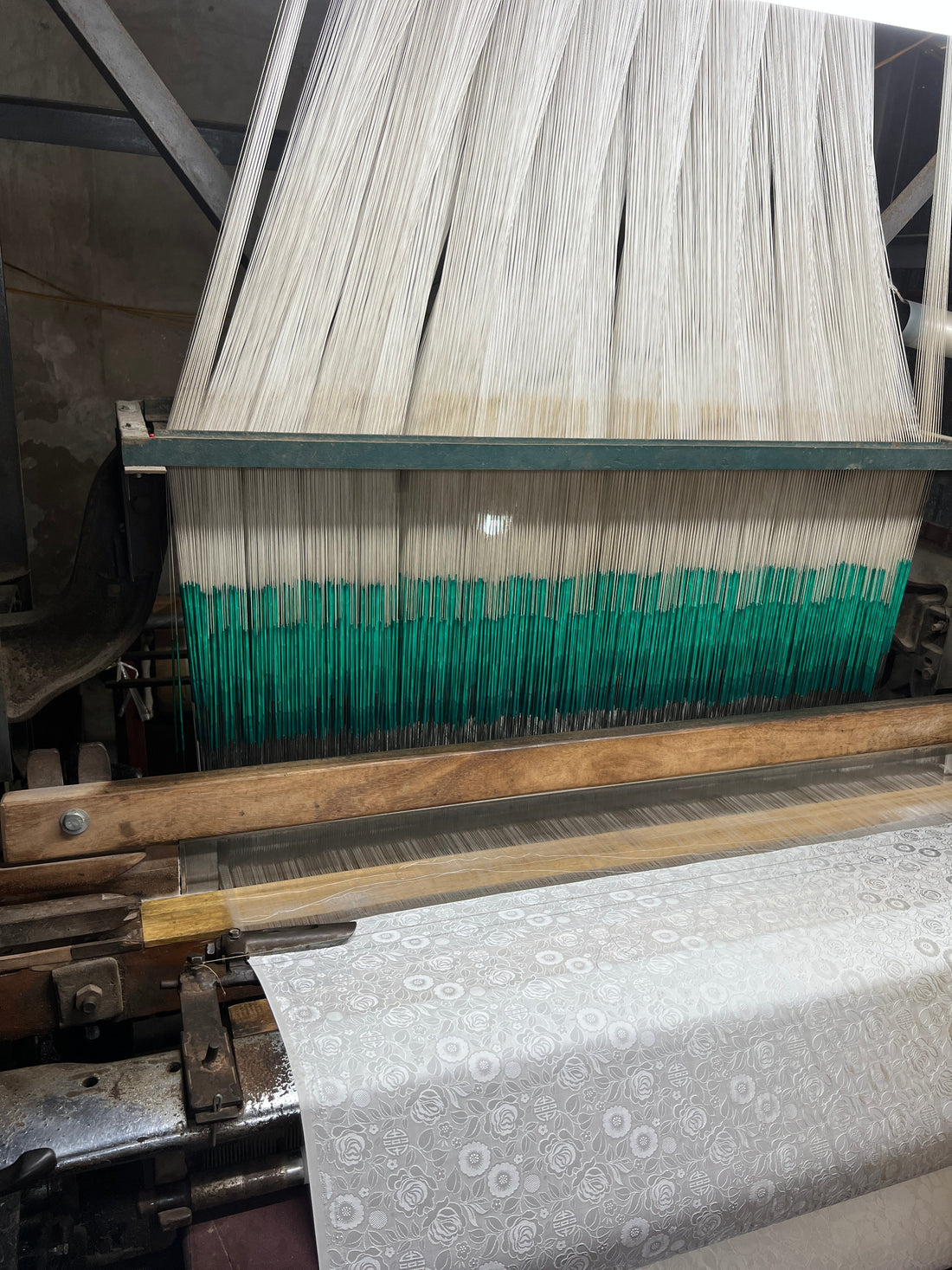Vietnamese Silk – A unique beauty in the global flow of silk

Share
Among many silk-weaving traditions around the world, Vietnamese silk stands out with its natural beauty and distinctive cultural depth. From unique natural materials like mulberry silk and lotus fiber to traditional dyeing and weaving techniques, Vietnamese silk carries a quiet elegance that reflects the spirit and soul of the Vietnamese people.
Local materials and cultural essence in every thread of Vietnamese Silk
Vietnamese silk is considered one of the country’s oldest traditional crafts, with a history that spans thousands of years. During the feudal era, Vietnamese silk was classified as a luxury tribute, reserved for royalty and aristocrats, and often used in diplomatic exchanges with neighboring countries.
Unlike many international silk products that are made using industrial methods and widely available materials, Vietnamese silk carries a deep connection to nature and local life. For generations, the Vietnamese people have creatively and sustainably used native resources. Beyond the traditional silkworm silk — made from the cocoons of silkworms raised on mulberry leaves — they have also succeeded in discovering and developing completely new materials, such as lotus silk.
 Silkworm silk is created through a strict five-step process: raising silkworms, cocoon formation, silk reeling, weaving, and dyeing. Each stage requires precision, care, and skilled techniques, taking about two months to complete a high-quality product. In addition, lotus silk — made from thousands of discarded lotus stems — holds the breath of the countryside, the hard work of artisans, and a uniquely rustic and pure beauty. Artisan Phan Thi Thuan was the first in Vietnam to bring this rare silk to life, turning what was once seen as waste into a refined cultural symbol.
Silkworm silk is created through a strict five-step process: raising silkworms, cocoon formation, silk reeling, weaving, and dyeing. Each stage requires precision, care, and skilled techniques, taking about two months to complete a high-quality product. In addition, lotus silk — made from thousands of discarded lotus stems — holds the breath of the countryside, the hard work of artisans, and a uniquely rustic and pure beauty. Artisan Phan Thi Thuan was the first in Vietnam to bring this rare silk to life, turning what was once seen as waste into a refined cultural symbol.
More than just the material, Vietnamese silk is also known for its natural dye techniques. Instead of using industrial dyes, artisans extract colours from tree bark, roots, leaves, and local herbs. The soft, earthy tones of naturally dyed silk not only highlight its gentle beauty but also ensure environmental friendliness, reflecting the harmony between people and nature in every product.
Beyond colours, the details and motives on Vietnamese silk also express deep layers of folk culture and spiritual beliefs. Motifs often feature images like phoenixes, dragons, lotus flowers, and especially traditional designs inspired by village communal houses and ancient Vietnamese characters.
Vietnamese silk is the result of a perfect blend between nature, human labor, and cultural depth. Within every thread and every piece of silk lies a story of origin, creativity, and the unique identity of the Vietnamese people — something no other type of silk in the world can fully replicate.
How Vietnamese silk differs from other types of silk
Vietnamese silk has a unique charm that sets it apart from many other famous types of silk around the world. Handwoven Vietnamese mulberry silk is known for its smooth texture and cool touch. A simple way to tell if a piece of silk is real is to crumple it lightly in your hand and then release it — if the fabric quickly returns to its original shape, it is likely pure mulberry silk, carefully woven by hand. This not only shows its quality, but also reflects the high level of craftsmanship of Vietnamese artisans.
Another clear difference lies in the patterns. While Chinese silk often features bright, colorful designs printed using industrial techniques, Vietnamese silk tends to have simpler, traditional patterns that are woven directly into the fabric. This method makes the details and motives more durable and gives the silk a deeper, more meaningful beauty — often inspired by ancient Vietnamese characters and cultural symbols.
In general, Vietnamese silk feels more subtle and calm — not flashy or overwhelming. But it is exactly this simplicity that creates a sense of elegance, gentleness, and lasting value. It is more than just a material for clothing; it represents a continuation of tradition, and a way for the Vietnamese people to express their soul, identity, and philosophy of life through each handcrafted piece.
Handcrafting in Vietnam: A living heritage
Creating a piece of silk in Vietnam is not just a production process — it is a journey deeply connected to traditional craft villages and cultural heritage. From planting mulberry trees, raising silkworms, reeling the silk, weaving the fabric, to dyeing it, every step reflects the close bond between people, nature, and generations of tradition. The artisans — or more precisely, the master craftsmen — do not simply pass down skills. They also pass down their soul, love for their homeland, and a strong sense of national pride through every thread of silk they create.

In today’s fast-paced world, where much of the warmth of traditional life seems to fade away, these silk villages remain like steady flames — quietly preserving the spiritual values and simple beauty of Vietnamese culture. Many of these villages have existed for centuries, including Co Do, Van Phuc, Nha Xa, Co Chat, Duy Duyen, Ma Chau (Quang Nam), and Tan Chau (An Giang).
Phung Xa Village, in My Duc District of Hanoi, is also one of Vietnam’s oldest silk-weaving villages, famous for its traditional craft known as “canh cuoi” (a term for weaving). This village is not only known for producing high-quality silk but also for preserving refined hand-weaving techniques passed down from generation to generation. Phung Xa silk carries the legacy of the craft village through its products like face towels, bath towels, blankets, and accessories — all made from 100% natural mulberry silk, known for being soft, shiny, and durable. In 2017, artisan Pham Thi Thuan from Phung Xa successfully developed a method to weave silk from lotus fiber. This breakthrough marked a significant milestone in the village’s history and was seen as a proud moment for both Phung Xa and the broader Vietnamese silk industry.
Vietnamese silk is more than just fabric — it is a true work of art, rich in cultural meaning and filled with the spirit of Vietnam.
GAMME Collective preserving cultural identity in a modern world
In today’s globalized world, where fashion trends change quickly and mass-produced products dominate the market, preserving traditional values can be a real challenge. However, GAMME Collective has shown a thoughtful and creative approach by blending centuries-old cultural heritage with modern, stylish design.

GAMME Collective is not just a fashion brand - it is a cultural messenger, bringing the soul of Vietnamese craft villages to the world. The brand’s designs remain true to Vietnamese beauty: soft, elegant, and gentle. GAMME Collective acts as a bridge between the past and the present, connecting traditional values with modern creativity, and helping to share Vietnamese cultural identity in a lasting, meaningful way within the global fashion scene.
Instead of following fast, cheap, and mass-market trends, GAMME Collective focuses on sustainability, craftsmanship and personalized design. Each product tells a story — about a craft village, an artisan, and the spirit of Vietnamese culture that lives on through their hands and hearts.




